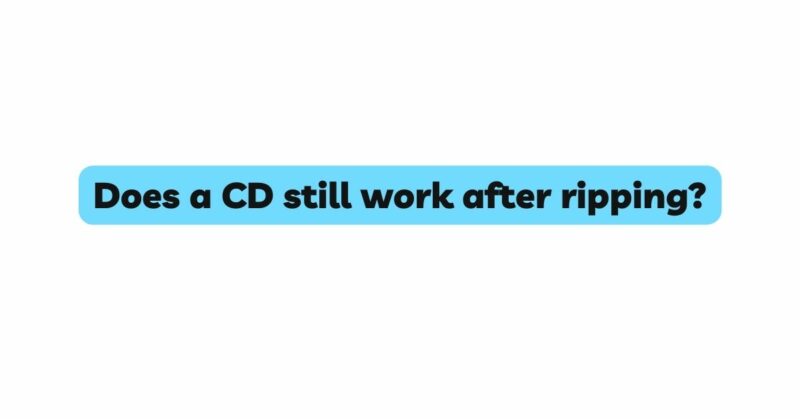In the ever-evolving landscape of music consumption, the practice of ripping CDs has become a widespread phenomenon. As individuals transition from physical media to digital formats, a common question arises: Does a CD still work after ripping? This article seeks to demystify this query, exploring the technical underpinnings of CD ripping, the impact on the original disc’s functionality, and the broader implications for music enthusiasts.
Understanding CD Ripping: Before delving into the core question, it’s crucial to comprehend the essence of CD ripping. CD ripping involves extracting the audio data stored on a compact disc and converting it into a digital format. This process entails using specialized software to read the digital information from the disc’s surface, translating it into a recognizable audio file. The primary purpose is to create a digital duplicate of the original audio content for convenient playback on digital devices.
Mechanics of CD Ripping: Contrary to the notion that a CD’s functionality is compromised after ripping, the process itself is non-destructive. The ripping software scans the CD’s surface, interpreting the binary data encoded as microscopic pits and lands. This data is then translated into a digital audio format, such as MP3 or FLAC, without altering or damaging the physical disc. In essence, the ripping process creates a copy of the audio data, leaving the original CD intact.
Preservation vs. Alteration: It’s important to differentiate between preservation and alteration when it comes to CD ripping. Preservation involves safeguarding the original content by creating a digital backup, ensuring the longevity of the music. Alteration, on the other hand, implies making changes to the original content. CD ripping falls squarely into the preservation category, as it leaves the CD’s functionality unchanged while generating a digital replica of the audio data.
Functionality Post-Ripping: After a CD has been ripped, its functionality remains entirely intact. The disc can still be played on CD players and audio systems as it did before the ripping process. The act of ripping does not impair the disc’s ability to transmit audio signals or interact with playback devices. In essence, the CD retains its original purpose while coexisting with its digital counterpart.
Digital Transformation: Ripping a CD represents a transformative moment for the audio content. The transition from an analog physical medium to a digital format opens up a world of convenience and versatility. Digital files can be easily stored, organized, and accessed across a variety of devices. This transformation amplifies the music’s reach and accessibility, enhancing the overall listening experience.
Quality Considerations: While the functionality of a CD remains unaffected after ripping, there are quality considerations to address. The choice of file format and compression settings can impact the audio quality of the ripped tracks. Lossless formats like FLAC preserve the original audio fidelity without any loss of data, while lossy formats like MP3 sacrifice some audio detail for smaller file sizes. Users must make informed decisions based on their priorities, whether it’s pristine audio quality or efficient storage utilization.
Collective Impact on Physical Media: The rise of digital music consumption has led to a decline in physical media sales, including CDs. However, the functionality of a CD after ripping highlights the coexistence of both formats. Physical CDs, even after being ripped, retain their functional integrity, catering to those who value the tactile experience and audio fidelity of physical discs. Simultaneously, the digital transformation enables users to embrace the convenience and portability of digital formats.
Legal and Ethical Considerations: While ripping a CD for personal use is generally considered legal in many jurisdictions, legal and ethical considerations come into play when sharing or distributing ripped content. Copyright laws and licensing agreements vary by region and circumstance. It’s crucial for users to understand the legal implications and respect the rights of artists and copyright holders when dealing with ripped content.
Conclusion: A Harmonious Coexistence: In the realm of music technology, myths and misunderstandings can obscure the truth. The question of whether a CD still works after ripping is resoundingly answered in the affirmative. CD ripping, far from compromising a disc’s functionality, allows it to seamlessly coexist with its digital counterpart. The process preserves the essence of the original content while embracing the convenience and accessibility of the digital age. As music enthusiasts straddle both worlds, the journey of a CD from physical entity to digital entity underscores the harmonious coexistence of past and present, analog and digital, in the captivating symphony of music appreciation.


